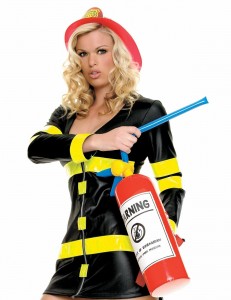Fire is the ultimate fear in the back of every event planner’s mind. Nothing else is more disastrous or devastating to an event, or even more dangerous to its attendees. With increased popularity in pyrotechnics, fire performers, and high-tech visual displays, having the proper fire safety precautions in place has never been more crucial. Regardless if an open flame is present, fire can start from a hot bulb, exposed wiring, or overloaded power strips. And with the right conditions in place, it only takes a few seconds for a small fire to turn into a raging inferno. Below we explore a checklist of the top ten precautions you should have in place when preparing for your next event.
1. Clearly-Marked Exits: Exits must be clearly-marked, unobstructed, illuminated, and frequent, depending on the size of your event.
2. Photoluminescent Paths – All paths to exits should be lined with photoluminescent (AKA glow-in-the-dark) tape, so guests can still find a way out in the event the room should fill with smoke. Whether it’s already in place or not, photoluminescent tape is relatively cheap, easy to use, and inconspicuous.
3. Communicated Evacuation Plan – All event workers and volunteers must be informed of the event floor plan and evacuation plan in case of a fire. Additionally, this information must be communicated to the attendees, whether via announcement, in an event guide/program, or posted on the event walls.
4. Fire Extinguishers – These should be easily accessible and frequent, especially in places where fires are more prevalent such as kitchens, audio-visual booths, and anywhere near an open flame. In addition they should be refilled and tested prior to the event.
5. Avoid High-Risk Décor/Wiring – Obviously bulbs, cords, and open flames should not be near or touching any fabrics or other combustible materials. Flame retardant spray on curtains, draperies, or any other hangings can help further prevent any sort of ignition.
6. No Overloaded Cords/Power Strips – Power strips are intended for their designated number of outlets only. Piggy-backing of electrical conduits, whether it be with power strips or extension cords (often called “daisy-chaining”) should be restricted, as any blows can cause a fire spark.
7. Restriction of Flammable Liquids – All flammable liquids should be restricted within the event with the exception of those that are highly regulated for performance, cooking, or space heating. Proper handling of flammable liquids should be carried out by qualified professionals.
8. Stay Within Capacity – Over-capacitating leads to trampling and injury in cases of emergency. Take note of a building’s capacity and stay within range, as well as provide ample spacing between tables and maintain wide unobstructed aisles for easy escape.
9. Fire Alarm Maintenance – Most indoor venues have a pre-existing fire detection system involving smoke detectors, alarms, and sprinklers. Make sure these are tested and operating correctly prior to the event.
10. Driveways, Fire lanes, & Parking Should Be Unobstructed – Make sure there is a clear and easy path to the event for emergency personnel in case of a fire. Driveways, fire lanes, parking, and hydrants should be kept unobstructed.


